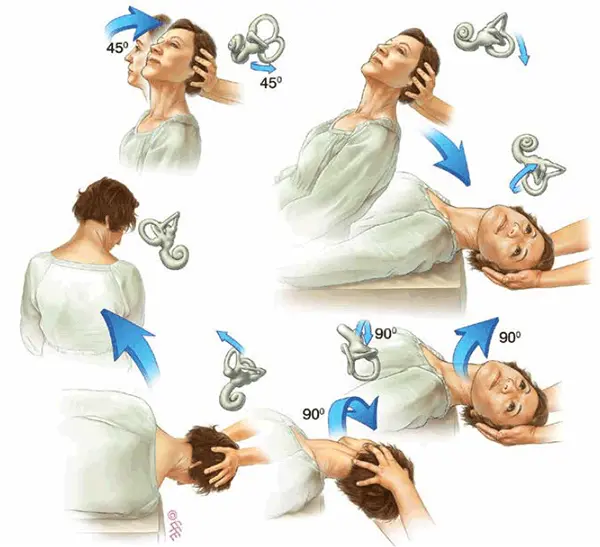Epley Maneuver: A Treatment for Vertigo
Understanding the Epley Maneuver
Introduction to Vertigo
Vertigo is that unsettling sensation where it feels like the world around you is spinning, even when you’re standing still. If you’ve ever felt dizzy after a quick spin or sudden head movement, you’ve experienced a mild form of vertigo. But for many, vertigo can be a recurring issue, significantly impacting their daily lives.
What is Vertigo?
Vertigo is more than just dizziness. It’s a specific type of dizziness characterized by the feeling that you or your surroundings are moving or spinning. This sensation can be triggered by various factors, ranging from inner ear problems to certain medications, and even migraines.
Common Causes of Vertigo
One of the most common causes of vertigo is Benign Paroxysmal Positional Vertigo (BPPV). BPPV occurs when tiny calcium particles in the inner ear, called otoconia, become dislodged and migrate into the semicircular canals. This displacement disrupts the signals your brain receives about head movements, leading to the spinning sensation associated with vertigo. People over the age of 50, those with a history of head trauma, or individuals with certain inner ear conditions are more susceptible to BPPV. Women are also slightly more prone to BPPV compared to men.
Overview of the Epley Maneuver
The Epley maneuver is a widely recognized and effective treatment for BPPV, a specific form of vertigo. It’s a series of head movements that help reposition the dislodged otoconia, bringing them back to their proper location in the ear.
History and Development
Dr. John Epley, an American otolaryngologist, developed this maneuver in the 1980s. Before its introduction, treatments for vertigo were more invasive and less effective. The Epley maneuver revolutionized how vertigo, specifically BPPV, is treated, offering a simple, non-invasive solution.
How the Epley Maneuver Works
The maneuver involves moving the head through a sequence of positions designed to move the otoconia out of the semicircular canals. As the head is moved, gravity helps shift the particles back into the correct chamber of the ear, alleviating the symptoms of vertigo.
The Science Behind the Epley Maneuver
Anatomy of the Inner Ear
To understand how the Epley maneuver works, it’s crucial to grasp the basics of inner ear anatomy.
The Role of the Vestibular System
The vestibular system, located within the inner ear, is responsible for maintaining balance and spatial orientation. It includes three semicircular canals that detect rotational movements of the head and two otolithic organs (the utricle and saccule) that detect linear movements.
Understanding Otoconia and Their Role in Vertigo
Otoconia are tiny calcium carbonate crystals found in the otolithic organs. These crystals are essential for detecting gravity and linear acceleration. However, when these particles dislodge and move into the semicircular canals, they interfere with normal balance signals, causing vertigo.
How the Epley Maneuver Targets Vertigo
The primary goal of the Epley maneuver is to move these dislodged otoconia back to their original location, where they no longer cause issues.
Realignment of Otoconia
Through a series of head movements, the maneuver uses gravity to guide the otoconia out of the semicircular canals and into the utricle, where they can no longer trigger vertigo. This realignment is key to alleviating the symptoms of BPPV.
Restoring Balance and Reducing Symptoms
Once the otoconia are back in place, the vestibular system can function correctly, reducing or even eliminating the dizziness and spinning sensations of vertigo.
Step-by-Step Guide to Performing the Epley Maneuver
If you’ve been diagnosed with BPPV, your healthcare provider may recommend performing the Epley maneuver at home. Here’s a step-by-step guide to help you do it correctly.
Preparation Before the Maneuver
Before you start, it’s important to prepare adequately to ensure the maneuver is both effective and safe.
Necessary Precautions
Make sure you have someone with you when performing the maneuver, especially if it’s your first time. The maneuver can sometimes cause dizziness, so it’s wise to have assistance nearby. Avoid eating a heavy meal right before performing the maneuver to minimize the risk of nausea.
What to Avoid Before and After the Procedure
Before performing the Epley maneuver, avoid engaging in activities that may exacerbate dizziness, such as driving or operating heavy machinery. It’s best to perform the maneuver in a safe environment where you can rest afterward. After completing the maneuver, refrain from driving or undertaking tasks that require balance and coordination until you are sure that the dizziness has subsided. Allow yourself time to recover and ensure you’re in a safe position before resuming normal activities.

Step 1: Starting Position
Sit on your bed with your legs stretched out in front of you. Turn your head 45 degrees to the side where you experience the most vertigo. This position is crucial as it aligns your inner ear correctly for the maneuver.
Step 2: First Head Turn
Quickly lie down on your back with your head still turned at a 45-degree angle. Ensure your head is slightly hanging off the edge of the bed. Hold this position for about 30 seconds or until the dizziness subsides.
Step 3: Lying on the Side
Next, turn your head 90 degrees in the opposite direction without lifting it. Now, turn your whole body to the side so that you’re lying on your side with your nose pointed downward. Stay in this position for another 30 seconds.
Step 4: Returning to Sitting Position
Slowly return to a sitting position by swinging your legs off the bed and sitting up. Keep your head slightly tilted downward. Stay seated for a few minutes to allow your inner ear to adjust.
Tips for Proper Execution
Common Mistakes to Avoid
One common mistake is moving too quickly between positions. The key to a successful Epley maneuver is to move slowly and deliberately to give the otoconia time to settle. Another mistake is not maintaining the head positions for the recommended amount of time.
How Often to Perform the Maneuver
It’s typically recommended to perform the Epley maneuver once or twice a day until your symptoms resolve. However, always follow the specific advice given by your healthcare provider.
Effectiveness and Benefits of the Epley Maneuver
Success Rates
The Epley maneuver is highly effective for treating BPPV, with success rates ranging from 80% to 90% after just one session. Many patients experience immediate relief, although some may require multiple sessions.
Clinical Studies and Research Findings
Numerous studies have validated the efficacy of the Epley maneuver. For instance, a study published in The Journal of Neurology found that the maneuver significantly reduced vertigo symptoms in over 80% of participants.
Patient Testimonials and Experiences
Many patients report rapid relief from vertigo after performing the Epley maneuver. Stories often describe how life-changing it can be to finally have a solution to the debilitating effects of vertigo.
Benefits Beyond Vertigo Relief
Non-Invasive and Drug-Free
One of the biggest advantages of the Epley maneuver is that it’s a non-invasive, drug-free treatment. This is particularly beneficial for individuals who may be sensitive to medications or who prefer natural treatment options.
Quick Relief from Symptoms
Unlike some treatments that can take weeks or months to show results, the Epley maneuver often provides immediate relief. This quick resolution allows patients to return to their daily activities without the burden of vertigo.
Potential Side Effects and Risks
Short-Term Side Effects
While the Epley maneuver is generally safe, there are a few potential side effects to be aware of.
Dizziness and Nausea
It’s common to experience dizziness or nausea immediately after the maneuver. These symptoms are usually temporary and subside within a few minutes to an hour.
Fatigue and Discomfort
Some people may feel fatigued or uncomfortable after performing the maneuver. This is normal and typically resolves on its own without the need for further intervention.
Long-Term Considerations
Recurrence of Vertigo
While the Epley maneuver is highly effective, BPPV can recur, meaning some individuals may need to perform the maneuver periodically. If vertigo symptoms return frequently, it’s important to consult with a healthcare provider for further evaluation.
When to Seek Medical Attention
If your vertigo persists despite performing the Epley maneuver, or if you experience unusual symptoms such as severe headaches, vision changes, or hearing loss, seek medical attention immediately. These could be signs of a more serious condition.
When to Perform the Epley Maneuver
Timing and Frequency
Perform the Epley maneuver at the onset of vertigo symptoms or as directed by your healthcare provider. The frequency of the maneuver can vary based on individual needs and the severity of symptoms.
Guidance from Healthcare Providers
Consult with a healthcare provider before starting the Epley maneuver, especially if you have never performed it before. They can provide personalized instructions and ensure that it’s the appropriate treatment for your specific condition.
Additional Considerations
What If You Perform the Maneuver on the Wrong Side
Performing the Epley maneuver on the incorrect side may not only fail to relieve symptoms but could also exacerbate them. The maneuver targets specific dislodged particles in the semicircular canals, and incorrect positioning may cause the particles to shift to a different canal or worsen vertigo symptoms. For this reason, it is crucial that patients do not attempt to perform the maneuver themselves without proper guidance. Chiropractors can accurately diagnose BPPV by taking a detailed medical history and performing specific examinations to determine which side is affected. They can then guide or perform the maneuver correctly, ensuring it targets the correct side and is done safely.
Is It Possible to Get BPPV on Both Sides
It is possible to develop BPPV on both sides, although it is relatively rare. Some individuals may experience vertigo on one side initially and later develop symptoms on the other side. This condition is referred to as bilateral BPPV.
Management of Bilateral BPPV
If you suspect you have BPPV on both sides, it is essential to seek professional evaluation. A healthcare provider can accurately diagnose and treat each side appropriately, often using modified versions of the Epley maneuver or other treatments.
Why Patients Should Seek Professional Chiropractors Help
Patients with BPPV should avoid performing the Epley maneuver on their own. Incorrectly executing the maneuver can lead to further complications or ineffective treatment. Chiropractors can accurately diagnose BPPV by taking a detailed medical history and performing specific examinations to determine which side is affected. They can then guide or perform the maneuver correctly, ensuring it targets the correct side and is done safely.
Conclusion
The Epley maneuver is a proven, effective treatment for BPPV, offering relief from vertigo symptoms through a non-invasive approach. Understanding the proper execution, potential side effects, and the importance of professional guidance can help ensure that you get the most benefit from this treatment. For those experiencing persistent or recurring vertigo, seeking professional advice is crucial for effective management and long-term relief.
FAQs
Q: How long does it take for the Epley maneuver to work?
A: Many patients experience relief within a few hours, though it may take a day or two for full resolution.
Q: Can I perform the Epley maneuver on my own?
A: It’s best to have a healthcare professional perform the maneuver or guide you through it to ensure it’s done correctly.
Q: What should I do if the Epley maneuver doesn’t work?
A: If symptoms persist, consult your healthcare provider for further evaluation and possible alternative treatments.
Q: Are there any lifestyle changes that can help prevent BPPV?
A: Maintaining a healthy lifestyle, managing stress, and avoiding sudden head movements can help reduce the risk of BPPV. Regular check-ups with a healthcare provider can also aid in early detection and management.

